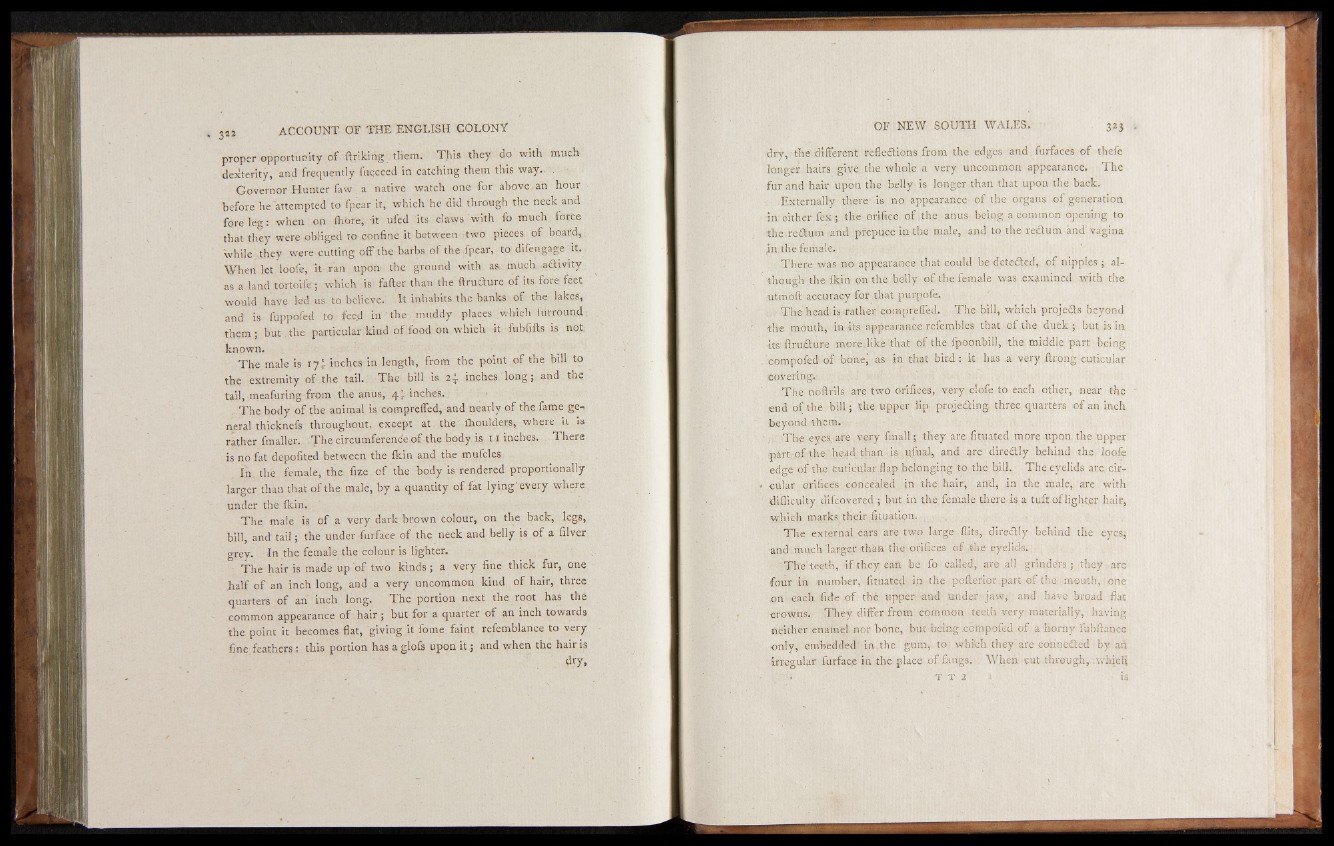
proper opportunity o f ftrlking them. This they do with much
dexterity, and frequently fucceed in catching them this way.. .
Governor Hunter faw a native watch one for above, an hour
before he~attempted to fpear it, which he did through the neck and
fore le g : when on {höre, -it ufed its claws with fo much force
that they were obliged to confine it between two pieces o f board,
while they were cutting off the: barbs of the fpear, to difengage it.
When let loofe, it ran upon the ground with as, much a&ivity
as a land tortoife ; which is fafter than the ftrudure of its fore fpet
would have led us to believe. It inhabits the banks of the lakes,
and is luppofed to feed in the muddy places which furround
them; but. the particular kind of food on which it fubhfts is not
known.
The male is iy^ mehes in length, from the point of the bill to
the extremity of the tail. The bill is 2^. inches long; and the
tail, meafuring from the anus, 4 t. inches.
The body of the animal is comprefled, and nearly of the fame general
thicknefs throughout, except at the' fhoulders, where it is
rather fmaller. The circumference o f the body is 1 1 inches. There
is no fat depofited between the fkin and the mufcles.
In the female, the fize of the body is rendered proportionally
larger than that of the male, by a quantity o f fat lying" every where
under the fkin.
The male is o f a very dark brown colour, on the back, legs,
bill, and tail; the under -furface of the neck and belly is of a filver
grey. In the female the colour is lighter.
The hair is made up o f two kinds ; a very fine thick fur, one
half o f an inch long, and a very uncommon kind o f hair, three
quarters of an inch long. The portion next the root has the
common appearance o f h a ir ; but for a quarter o f an inch towards
the point it becomes flat, giving it fome faint refemblance to very
fine feathers.; this portion has a glofs upon i t ; and when the hair is
dry, the different refle&ions from the edges and furfaces of thefe
longer hairs give the whole a very uncommon appearance. The
fur and hair upon the belly is longer-.than that upon the back.
, Externally there- is no appearance o f the organs o f generation
in either.fex; the orifice o f the anus being a common opening to
the redtum and prepuce in the male, and to the rectum and vagina
jn the female.1
There w a s no appearance that could be detected, o f nipples; although
the fkin on the belly o f the female was .examined with the
utmoft accuracy for that purpofe.
The head1 is-rather comprefled. The bill, which projects beyond
■ the mouth, in its appearance refembles that .of the duck ; but is in
•its ftradture mo re. like that of the fpoonbill, the middle part being
compofed of hónej as in that bird : it has a very .ftrong euticular
covering.-
The noftrils are two orifices, very- clofe to each other, near the
end of thé bill; the upper lip p-roje&ing three quarters of an inch
beyond them.
The eyes are very fmall; they- are fituated more upQn the upper
part of the head than is ufual, and are diredtly behind the loofe
edge of the euticular flap belonging to the bill. The eyelids are circular
orifices concealed in the hair, and, in the male, are with
difficulty difeovered ; but in the female there is a tuft of lighter hair,
which marks their-fituation.
The external ears are two large flits, diredtly behind the eyes;
■ and m u c h larger than the1 orifices o f the eyelids.
The teeth, if they can be fo called, are all grinders; they are
four in number, fituated in the pofterior part of the mouth, one
on each fide of the tipper and under jaw, and have broad flat
crowns. They differ from common teeth very materially, having
neither enamel nor hone, but being compofed o f a horny fubfiance
-only, embedded in the gum, to' which they are conneQed by an
irregular furface in the place o f fangs. When cut through, .which
T T 2 • ' is